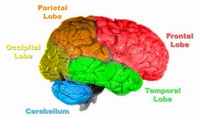Login form
Brain and Nervous System
 What kind of supercomputer can write stories, do math problems, draw pictures, play games, see through eyes, hear someone talking, talk back, and network with devices that make snacks in the microwave oven? Your brain and nervous system can do all these things. Do you think a computer will ever be as powerful as your brain?
What kind of supercomputer can write stories, do math problems, draw pictures, play games, see through eyes, hear someone talking, talk back, and network with devices that make snacks in the microwave oven? Your brain and nervous system can do all these things. Do you think a computer will ever be as powerful as your brain?
You think with your brain. Your brain also sends signals through a network called your nervous system. It tells your legs to walk and run. It tells your hands and arms to put popcorn in the microwave. You don’t even have to think about many of the things your brain does. Your brain tells your heart to beat. It tells your lungs to breathe in and out, even when you are sleeping.
Your brain also controls your feelings. Such feelings as joy, sadness, love, anger, and fear all come from your brain.
WHAT IS MY BRAIN MADE OF?
Your brain is made of about 100 billion nerve cells. It looks like a lump of pinkish-gray jelly. The surface of the brain is wrinkled, and deep grooves divide it into sections. A network of blood vessels brings oxygen and food to your brain cells and carries away wastes. Your brain is protected by bone called your skull. Liquid and skinlike tissues also protect your brain.
When you were born, your brain weighed about pounds (about 0.35 kilograms). Your brain keeps on growing while you grow up. By the time you reach the age of 20, your brain will weigh about 3 pounds (1.3 kilograms).
Your brain has three main parts. The parts are called the cerebrum, the cerebellum, and the brain stem. The cerebrum makes up the largest part of the brain. The cerebellum is underneath the back part of the cerebrum. The brain stem connects with the spinal cord at the bottom of the brain.
Your cerebrum and cerebellum are divided into two parts. These parts are called the right brain and the left brain. The right side of your brain controls the left side of your body. The left side of your brain controls the right side of your body. Nerves from the right and left side of your body cross over when they enter your brain.
WHAT DOES THE CEREBRUM DO?
Your cerebrum makes up most of your brain. Your cerebrum solves problems and makes wishes. All of your thinking goes on in your cerebrum. Speech, language, and emotions come from your cerebrum, especially your cerebral cortex. The cerebral cortex is the outer part of the cerebrum.
Your cerebrum also gets signals from your senses. Nerves carry the signals. Nerves from your eyes and ears go to parts of the cerebrum that let you see and hear. Nerves carry signals to your cerebrum that let you feel, smell, and taste.
Your cerebrum sends messages out along nerves. The messages tell your legs to walk or run. They tell your arm and hand to wave when you see a friend across the street.
WHAT DOES THE CEREBELLUM DO?
Your cerebellum coordinates and fine-tunes your body movements. Your cerebrum might tell your hands and arms to hit a baseball. Your cerebellum controls how you swing the bat and make contact with the ball.
Your cerebellum helps your fingers play the piano, guitar, or violin. It helps you keep your balance when you run, jump rope, or walk along a curb.
WHAT DOES THE BRAIN STEM DO?
Your brain stem takes care of all the things that you do but don’t need to think about doing. It keeps your heart pumping blood. It keeps your lungs breathing air. It makes your eyes blink. It pulls your hand back really fast if you touch a hot pot on the stove.
WHAT IS THE NERVOUS SYSTEM?
Your nervous system consists of the brain, spinal cord, and nerves that run throughout your body. The nervous system carries messages to your muscles and organs. These messages tell your body what to do.
Your spinal cord is made of bundles of nerves. It starts in your neck and goes down your back. Nerves go out from the spinal cord to other parts of your body. Nerves from the spinal cord extend to the tips of your fingers and toes. Your spine, or backbone, protects your spinal cord.
Source: Microsoft ® Encarta

